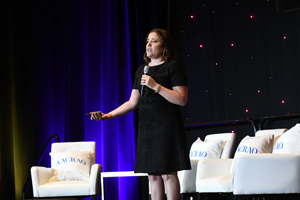
Sara Goldrick-Rab is a force for making #RealCollege transparent: stripping college’s media-polished sheen to reveal students’ actual lived experience. Her 35,000 Twitter followers are typically challenged to discover how to better serve
students in an authentic manner, and show that higher education professionals genuinely care about their well being.
Professor of Higher Education Policy and Sociology at Temple University, Goldrick-Rab’s research addresses socioeconomic and racial inequalities in higher education.
As the AACRAO SEM 2019 opening plenary speaker, she discussed food and housing insecurity for today’s students, and what higher ed professionals can do to help. This generation faces more austere times than their predecessors, she noted, and fundamental
economics have changed drastically since the 1980s and 1990s.
“The media depictions of today’s students are inaccurate. They’re not in college because they expect to get rich from it; they’re in college because [...] they hope for a decent life,” she said. “They want to do right
by their parents, their community. [W]e need to talk about all the pressure that they’re under.”
The new economics of college
According to Goldrick-Rab, the new economics of college include the following five challenges:
College prices are higher than ever.
Family incomes are stagnant.
Safety nets are shredded.
Work doesn’t pay as well.
Many colleges are underfunded.
With the gutting of welfare, the struggle to make ends meet with lower pay and purchasing power but skyrocketing tuitions, many students nowadays have to make a critical decision: what can they sacrifice to survive?
For a significant number, the choice comes down to fulfilling basic needs such as housing and food for the end goal of a college degree. Students find themselves asking whether they can work the graveyard shift for money and be able to wake up in time
for their 8 a.m. class.
Food and housing insecurities stem from these impossible choices--do they eat, or do they pay rent to make tuition? Minority and marginalized students are most at risk for these situations particularly Native American, African-American, Latinx and trans
students.
Judgment, compassion, and the role of the higher ed professional
Others find themselves with the impossible task of providing for their families while juggling schoolwork. Goldrick-Rab gave the example of a student who used part of his loans to help pay for his mother’s doctor’s visit, then was faced with
questions from higher education professionals about how he managed to use up his money so quickly.
“Don’t make students perform their poverty,” she said. Approach them with a compassionate and empathetic mindset. She too was guilty of judging students who slept in her class, only to realize that many of them were working long hours
at their jobs simply to be there. Instead of judging, learn to ask.
So what can you, the higher educational professional do to help? Be accessible, she advises. Go the extra mile to create a culture of caring for students.
And advocate. Advocate for greater access for students, expanding investments in basic needs, empowering students and professionals to lead policy and financing a model for higher ed that is inclusive and effective. You may be surprised at the change
one person can make.
Join AACRAO Gives -- donate to help support students struggling from food and housing insecurities.